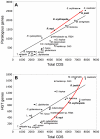The genome of a pathogenic rhodococcus: cooptive virulence underpinned by key gene acquisitions
- PMID: 20941392
- PMCID: PMC2947987
- DOI: 10.1371/journal.pgen.1001145
The genome of a pathogenic rhodococcus: cooptive virulence underpinned by key gene acquisitions
Abstract
We report the genome of the facultative intracellular parasite Rhodococcus equi, the only animal pathogen within the biotechnologically important actinobacterial genus Rhodococcus. The 5.0-Mb R. equi 103S genome is significantly smaller than those of environmental rhodococci. This is due to genome expansion in nonpathogenic species, via a linear gain of paralogous genes and an accelerated genetic flux, rather than reductive evolution in R. equi. The 103S genome lacks the extensive catabolic and secondary metabolic complement of environmental rhodococci, and it displays unique adaptations for host colonization and competition in the short-chain fatty acid-rich intestine and manure of herbivores--two main R. equi reservoirs. Except for a few horizontally acquired (HGT) pathogenicity loci, including a cytoadhesive pilus determinant (rpl) and the virulence plasmid vap pathogenicity island (PAI) required for intramacrophage survival, most of the potential virulence-associated genes identified in R. equi are conserved in environmental rhodococci or have homologs in nonpathogenic Actinobacteria. This suggests a mechanism of virulence evolution based on the cooption of existing core actinobacterial traits, triggered by key host niche-adaptive HGT events. We tested this hypothesis by investigating R. equi virulence plasmid-chromosome crosstalk, by global transcription profiling and expression network analysis. Two chromosomal genes conserved in environmental rhodococci, encoding putative chorismate mutase and anthranilate synthase enzymes involved in aromatic amino acid biosynthesis, were strongly coregulated with vap PAI virulence genes and required for optimal proliferation in macrophages. The regulatory integration of chromosomal metabolic genes under the control of the HGT-acquired plasmid PAI is thus an important element in the cooptive virulence of R. equi.
Conflict of interest statement
The authors have declared that no competing interests exist.
Figures







Similar articles
-
Evolution of the Rhodococcus equi vap pathogenicity island seen through comparison of host-associated vapA and vapB virulence plasmids.J Bacteriol. 2008 Sep;190(17):5797-805. doi: 10.1128/JB.00468-08. Epub 2008 Jul 7. J Bacteriol. 2008. PMID: 18606735 Free PMC article.
-
An Invertron-Like Linear Plasmid Mediates Intracellular Survival and Virulence in Bovine Isolates of Rhodococcus equi.Infect Immun. 2015 Jul;83(7):2725-37. doi: 10.1128/IAI.00376-15. Epub 2015 Apr 20. Infect Immun. 2015. PMID: 25895973 Free PMC article.
-
Comparative Genomics of Rhodococcus equi Virulence Plasmids Indicates Host-Driven Evolution of the vap Pathogenicity Island.Genome Biol Evol. 2017 May 1;9(5):1241-1247. doi: 10.1093/gbe/evx057. Genome Biol Evol. 2017. PMID: 28369330 Free PMC article.
-
The pathogenic actinobacterium Rhodococcus equi: what's in a name?Mol Microbiol. 2019 Jul;112(1):1-15. doi: 10.1111/mmi.14267. Epub 2019 Jun 17. Mol Microbiol. 2019. PMID: 31099908 Free PMC article. Review.
-
Molecular and infection biology of the horse pathogen Rhodococcus equi.FEMS Microbiol Rev. 2009 Sep;33(5):870-91. doi: 10.1111/j.1574-6976.2009.00181.x. Epub 2009 Apr 23. FEMS Microbiol Rev. 2009. PMID: 19453748 Review.
Cited by
-
Genome Structure of the Opportunistic Pathogen Paracoccus yeei (Alphaproteobacteria) and Identification of Putative Virulence Factors.Front Microbiol. 2018 Oct 25;9:2553. doi: 10.3389/fmicb.2018.02553. eCollection 2018. Front Microbiol. 2018. PMID: 30410477 Free PMC article.
-
The extracellular thioredoxin Etrx3 is required for macrophage infection in Rhodococcus equi.Vet Res. 2020 Mar 10;51(1):38. doi: 10.1186/s13567-020-00763-3. Vet Res. 2020. PMID: 32156317 Free PMC article.
-
A Novel Screening Strategy Reveals ROS-Generating Antimicrobials That Act Synergistically against the Intracellular Veterinary Pathogen Rhodococcus equi.Antioxidants (Basel). 2020 Jan 28;9(2):114. doi: 10.3390/antiox9020114. Antioxidants (Basel). 2020. PMID: 32012850 Free PMC article.
-
Genome analysis for the identification of genes involved in phenanthrene biodegradation pathway in Stenotrophomonas indicatrix CPHE1. Phenanthrene mineralization in soils assisted by integrated approaches.Front Bioeng Biotechnol. 2023 May 4;11:1158177. doi: 10.3389/fbioe.2023.1158177. eCollection 2023. Front Bioeng Biotechnol. 2023. PMID: 37214282 Free PMC article.
-
Membrane transport systems and the biodegradation potential and pathogenicity of genus Rhodococcus.Front Physiol. 2014 Apr 4;5:133. doi: 10.3389/fphys.2014.00133. eCollection 2014. Front Physiol. 2014. PMID: 24772091 Free PMC article. Review.
References
-
- Gurtler V, Mayall BC, Seviour R. Can whole genome analysis refine the taxonomy of the genus Rhodococcus? FEMS Microbiol Rev. 2004;28:377–403. - PubMed
-
- Larkin MJ, Kulakov LA, Allen CC. Biodegradation and Rhodococcus–masters of catabolic versatility. Curr Opin Biotechnol. 2005;16:282–290. - PubMed
-
- Muscatello G, Leadon DP, Klayt M, Ocampo-Sosa A, Lewis DA, et al. Rhodococcus equi infection in foals: the science of ‘rattles’. Equine Vet J. 2007;39:470–478. - PubMed
-
- Vazquez-Boland JA, Letek M, Valero A, Gonzalez P, Scortti M, Fogarty U. Rhodococcus equi and its pathogenic mechanisms. In: Alvarez HM, editor. Biology of Rhodococcus, Microbiology Mongraphs 16. Berlin Heidelberg: Spinger-Verlag; 2010. p. (in press).
Publication types
MeSH terms
Grants and funding
LinkOut - more resources
Full Text Sources
Other Literature Sources
Molecular Biology Databases
Miscellaneous

